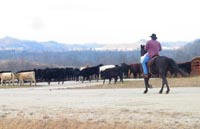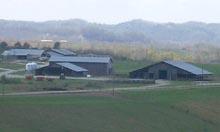East Kentucky Heifer Development Project Thriving
East Kentucky Heifer Development Project Thriving

 In 1998 when Knott County cattleman Dean Craft took a few heifers to the D&D Ranch in Perry County to participate in the Eastern Kentucky Heifer Development Project, he wasn’t sure what to expect. It was new back then, but Craft and others were determined to improve the quality of their beef cattle herds.
In 1998 when Knott County cattleman Dean Craft took a few heifers to the D&D Ranch in Perry County to participate in the Eastern Kentucky Heifer Development Project, he wasn’t sure what to expect. It was new back then, but Craft and others were determined to improve the quality of their beef cattle herds.
Now nearly seven years later, Craft’s cattle have gone from the below par straight to the top of the crop. Last year he had the three highest-priced heifers in the sale.
To be in the project, consignors bring spring-born heifers to D&D Ranch each October. The cattle are put on the same vaccination schedule and have to meet a strict pelvic measurement requirement to stay in the project. Heifers are bred at the ranch and most are sold each September in the East Kentucky Replacement Sale at the Lee County Stockyards. Some producers choose to bring their animals home to improve their own herds.
University of Kentucky Extension Agent for Agriculture and Natural Resources in Perry County Charles May is one of the project’s managers. Since the beginning he has seen vast improvements in the quality of eastern Kentucky cattle and management practices.
“We’ve really grown,” he said. “When we got a $134,000 Phase I Tobacco Settlement grant we were able to expand and automate our feeding system so we could accommodate more cattle. We went from about 200 three or four years ago to 600 this year.”
May said the project standards also have increased. Instead of the normal 150 square-centimeter pelvic measurements of most heifer programs, these cattle are required to have a measurement of at least 160 square centimeters.
“We track these animals after they are sold and we hear back if a buyer has had a problem,” May said. “We can track most of those problems back to an animal that just barely passed the pelvic measurement requirement. We are trying to eliminate as much calving difficulty as possible.”
Another improvement over the years is a steady increase in sale prices. May said that some of that can be attributed to higher cattle prices in general, however some of it stems from the project gaining a reputation for quality animals.
“People see the benefit of buying an animal in a program like this,” May said. “We started out averaging about $700 a head and in the last sale we averaged nearly $1,000. We know people are hearing a lot about these heifers and they are willing to pay more for them.”
Producers are not the only ones reaping benefits of the successful project. UK researchers and Extension agents have partnered with Morehead State University’s veterinary technician program. Morehead Veterinarian Phil Prater brings his classes to the ranch to get hands-on experience with large animals. They help out with vaccinations, deworming and fertility checks.
“It would be one thing for me to get up and lecture and say ‘this is what it feels like,’ but you don’t’ really know until you feel it yourself,” he said. “It’s a good experience for them. The UK faculty are helpful and they give them (students) a lot of opportunity.”
Prater said most of his students didn’t come from a farm background.
“The closest some of them have ever been to a beef cow is at the grocery store,” he said. “But once they get experience around large animals, they really like it.”
Another way MSU is contributing to the project is through Troy Wistuba. He’s been taking carcass ultrasound data on participating heifers. Wistuba is the only certified beef cattle ultrasound technician in Kentucky and one of only 107 in the United States. Via ultrasound, Wistuba measures back fat and rib eye area on heifers that meet the pelvic measurement requirement. He hopes the data will help them further improve their herds.
“By doing this, we should be able to increase carcass merit,” he said. “That will increase the quality of steaks at diners and restaurants.”
May said the data could also help producers make changes in their breeding programs.
“Hopefully we can use the data for someone who may have an animal where the rib eye area is not where it should be by a year of age,” he said. “They can then go out and purchase a bull to help increase that trait.”
Craft has learned a lot by participating in the project and has changed some of his management strategies at home as a result of his involvement.
“I now use EPDs and registered Angus bulls at home,” he said. “I watch the end product and try to keep birth and weaning weights consistent. I’d recommend anyone to get into this project. If there is a problem with your cattle, they tell you and they tell you what to do to correct it.”
At 600 heifers, the project is operating at or near full capacity with consignors from Virginia, West Virginia, Indiana and all around Kentucky. May said they are out of land and can’t expand any further.
“We started over seven years ago and I never knew where we’d be by now, but it just keeps getting bigger and better,” he said. “This year we actually had to turn some people away.”
